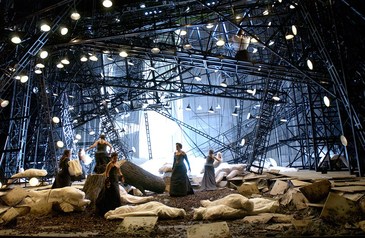 A scene from the COC's Die Walküre Photo: Michael Cooper.
A scene from the COC's Die Walküre Photo: Michael Cooper. The COC’s current production of Die Walküre is the first we’ve seen of the company’s Ring since the 2006 cycle. And, after seeing the revival on Thursday evening (Feb. 19), I’m pleased to say that it has returned in grand style.
The grand sweep of the production is simply stunning. Levine’s stark setting of a bombed-out theatre – with lighting booms akimbo and a blasted hole in the centre of the stage – is engagingly evocative yet not explicit. Is he hinting at the impending downfall of the gods? Or is it perhaps a reference to the destruction of European opera houses in World War II? It’s hard to say – but it’s a powerful image, nevertheless.
As well, the production is greatly enriched through attention to detail. The Valkyries’ big scene is made fascinating to watch, as they stack up shrouded hero-cadavers like ants organizing larvae. And when Siegmund “accidentally” cuts Sieglinde’s hands with his new sword, their blood-bond is underscored. Also striking is the projected flame on Brünnhilde – all that’s needed to create an otherworldly eerieness as she decrees Siegmund’s fate. As well, Hunding’s “wife-beater” tank-top shirt speaks volumes about him, as soon as he steps on stage.
The combined efforts of Egoyan and conductor Johannes Debus effectively brings the audience into the “Wagner zone” – a place where time passes slowly yet with profound and inevitable purpose. Egoyan limited the stage action to what was necessary and logical – he doesn’t try to fill the piece up with extraneous movement – and in this way he emphasizes the most significant moments. And in Debus’s hands, Wagner’s massive score – brilliantly played by the COC Orchestra – was taut and muscular, with a constant ebb and flow spanning whole acts.
Soprano Christine Goerke, in the role of Brünnhilde, has been widely touted as the “star” of this production. Indeed, she has a glorious voice, soaring and powerful. (Her “Hojotohos” were spine-tingling!) Moreover, she artfully negotiated the shifting emotions in her complex character. But the success of this Walküre doesn’t lie in one singer’s triumph. It was a great ensemble production, across the board.
Tenor Clifton Forbis, singing the role of Siegmund, was the focus of attention, as he had to withdraw for a time, earlier in the opera’s run, due to ill health. At first it wasn’t clear if he was still under the weather, or merely pacing himself. But with his cry of “Wälse!”, it was clear that he had all the vocal strength he needed. Cast as Siegmund’s enemy Hunding, Dmitry Ivashchenko was a consistently dark and menacing bass.
As Wotan, baritone Johan Reuter had an edgy “Bayreuth bark” in his vocal delivery – not a bad thing for the ruler of the gods – and he threw himself into the role of Wotan with commanding energy. But mezzo Janina Baechle proved his match as Fricka. Her voice was strident and forceful, and she summoned all the imperious indignation of a Queen Victoria who was most definitely not amused. As well, soprano Heidi Melton was a lush-voiced and dramatically sympathetic Sieglinde.
In short, this revival of Die Walküre is one of those magical theatrical events that is greater than the sum of its parts. It represents the best that the COC can do, and has done. And it demonstrates that the COC’s best is as good as anyone’s.
© Colin Eatock 2015
 RSS Feed
RSS Feed

